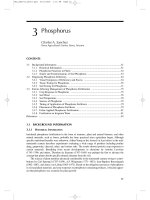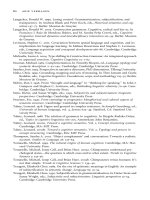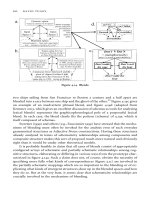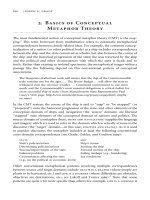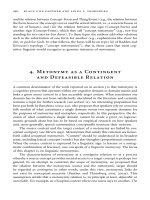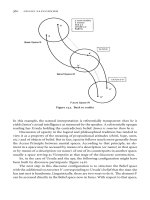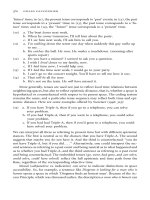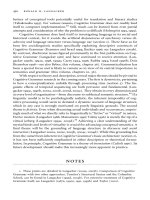Handbook of EEG interpretation - part 3 ppsx
Bạn đang xem bản rút gọn của tài liệu. Xem và tải ngay bản đầy đủ của tài liệu tại đây (1.57 MB, 29 trang )
FIGURE 1.38. A right benign epileptiform transients of sleep (BETS) in the
temporal region during stage 2 sleep. Note the higher amplitude in the T1 and
T2 channel with a longer interelectrode distance.
D
ifferent terms describe the small sharp spikes. or benign epilepti-
form transients of sleep, or benign sporadic sleep spikes of sleep
that depict a low-voltage (<50 µV), brief-duration (<50 msec), simple
waveform with a monophasic or diphasic spike. This benign variant
of uncertain significance has the morphology of a spike, although it
has an rapidly ascending limb and steep descending limb best seen in
the anterior to mid-temporal derivations during non-REM sleep. They
are most common in adults. They may be >50 µV, have a duration >50
msec, and may appear with an aftergoing slow-wave (usually of lower
amplitude than the spike). They are not associated with focal slowing.
They do not occur in runs. The most distinguishing characteristic is
that they disappear in slow-wave sleep. They appear as a unilateral
discharge but are almost always independent when they are bilateral.
They may possess a field that may correspond to an oblique transverse
dipole resulting in opposite polarities over opposite hemispheres when
they are bilateral.
CHAPTER 1
46
FIGURE 1.39. Wicket waves maximal at T3 and T4.
W
icket spikes are most commonly seen in adults >30 years of
age. They occur within the 6- to 11-Hz band, and can obtain
amplitudes of up to 200 µV. They are seen over the temporal regions
during drowsiness and light sleep and are usually bilateral and inde-
pendent. They typically occur in bursts, although they may be con-
fused with interictal epileptiform discharges, especially when they
occur independently or as isolated waveforms. No focal slowing or
aftergoing slow-wave component is seen, and they likely represent
fragmented temporal alpha activity. Similar frequency and morphol-
ogy of bursts to the isolated waveforms is a means of providing sup-
port for the nonepileptogenic origin. Wicket waves are considered an
epileptiform normal variant though they may be easily mistaken as
abnormal sharp waves.
Normal EEG
47
FIGURE 1.40. SREDA in a 73-year-old patient during hyperventilation
(HV). No clinical signs were present.
CHAPTER 1
48
I
n contrast to many of the patterns of uncertain significance that
mimic IEDs, subclinical rhythmic electrographic discharge in adults
(SREDA) is a pattern that mimics the epileptiform characteristics of a
subclinical seizure. However, no clinical features exist during it, either
subjective or objective findings, and no association with epilepsy has
been demonstrated. In contrast to most benign variants, SREDA is
more likely to occur in those over 50 years of age and also while the
person is awake. It may exist in two forms, either as a bilateral
episodic burst of rhythmic sharply contoured 5- to 7-Hz theta fre-
quencies appearing maximal over the temporoparietal derivations or
as an abrupt mononphasic series of repetitive sharp or slow wave-
forms that appear focally at the vertex recurring in progressively
shorter intervals until a sustained burst is noted. Rarely the two forms
may appear in the same person (personal observation WOT). Bursts
of SREDA usually last between 40 and 80 sec and occur without pos-
tictal slowing.
Normal EEG
49
ADDITIONAL RESOURCES
Abou-Knalil B, Misulis KE. Atlas of EEG and Seizure Semiology. Butterworth
Heinemann, Philadelphia, 2006:1–213.
Benbadis SR, Tatum WO. Overinterpretation of EEGs and misdiagnosis of
epilepsy. J Clin Neurophysiol 2003;20:42–44.
Blume WT, Masako K, Young GB. Atlas of Adult Electroencephalography.
2nd ed. Lippincott Williams & Wilkins, Philadelphia, 2002:1–531.
Kellaway Peter. Orderly approach to visual analysis: elements of the normal
EEG and their characteristics in children and adults. In: Ebersole JS, Pedley
TA, eds. Current Practice of Clinical Electroencephalography. 3rd ed.
Lippincott Williams & Wilkins, Philadelphia, 2003:100–159.
Markand, Omkar N. Pearls, perils, and pitfalls in the use of the electroen-
cephalogram. Semin Neurol 2003;23(1):7–46.
Olejniczak P. Neurophysiologic basis of EEG. J Clin Neurophysiol 2006;23(3):
186–189.
Tatum WO, IV, Husain A, Benbadis SR, Kaplan PW. Normal human adult
EEG and normal variants. J Clin Neurophysiol 2006;23(3):194–207.
Westmoreland BF. Benign electroencephalographic variants and patterns of
uncertain clinical significance. In: Ebersole JS, Pedley TA, eds. Current
Practice of Clinical Electroencephalography. 3rd ed. Lippincott Williams
& Wilkins, Philadelphia, 2003:235–245.
CHAPTER 1
50
51
CHAPTER 2
Abnormal
Nonepileptiform
EEG
SELIM R. BENBADIS
I
nterictal EEG provides information about the presence of
nonepileptiform electrophysiological dysfunction. When abnor-
malities are encountered, they are not specific for an underlying
etiology, and as such represent abnormalities without further differen-
tiation of the pathological process. While neuroimaging demonstrates
anatomical definition, EEG provides evidence of organic electrophys-
iological dysfunction.
The EEG is sensitive to cerebral dysfunction, but may have a lag
during clinical improvement or lead relative to maximal clinical symp-
tomatology. Many of the patterns that are nonepileptiform are non-
specific in etiology, yet the presence of abnormality is often a
reflection of the clinical presence and degree of dysfunction. Acuity is
unable to be demonstrated by EEG in nonepileptiform abnormalities,
although serial tracing may further help to define the trend toward
neurological evolution of improvement or deterioration. Therefore,
EEG is able objectively to substantiate and quantify to a degree the
depth of encephalopathy when diffuse nonepileptiform abnormalities
are encountered and lateralize (or even localize) abnormalities when
focal areas of slowing are evident. Many nonepileptiform and epilep-
tiform abnormalities characterize encephalopathy. This chapter will
focus on generalized and focal nonepileptiform abnormalities.
Chapters 3 and 5 will discuss patterns that are associated with epilep-
tiform abnormalities and patterns of special significance.
CHAPTER 2
52
Diffuse slowing on the EEG may have various morphologies, and occur intermit-
tently or continuously, to reflect abnormal cerebral function.The presence of diffuse
slowing suggests a bilateral disturbance of cerebral function and represents an
encephalopathy that is nonspecific for etiology.
FIGURE 2.1. An abnormal high-amplitude burst of diffuse intermittent
theta in an awake adult following a motor vehicle accident associated with
driving under the influence.
I
ntermixed diffuse intermittent theta in the most alert state is nor-
mal in young adults. When theta frequencies are seen in the frontal
or frontocentral regions and voltages are >100 µV or when theta is
present >10% of the time in an adult (not in childhood or elderly),
then theta may reflect a nonspecific abnormality similar to diffuse
intermittent slowing or background slowing, but may be seen nor-
mally in young adults. The slower the frequency, the higher the ampli-
tude, and the greater the persistence, the more likely intermittent theta
is abnormal.
Abnormal Nonepileptiform EEG
53
DIFFUSE SLOWING
FIGURE 2.2. Generalized monomorphic 5 to 6-Hz theta frequencies
obtained during syncope in a patient undergoing head-up tilt table testing for
neurocardiogenic syncope.
D
iffuse (or generalized) slowing in the background reflects a non-
specific abnormality and is indicative of a bilateral disturbance
of cerebral function. Progression of abnormal intermixed intermit-
tent slowing in the case of generalized abnormal nonepileptiform fea-
tures include initially intermixed intermittent theta (sometimes
normal as discussed above), with a greater degree of abnormality,
intermittent slowing becomes continous and theta slowing is replaced
by delta frequencies.
CHAPTER 2
54
FIGURE 2.3. Slowing of the posterior dominant rhythm to 6 Hz. This well-
defined background is too slow even in a 65-year-old man.
B
ackground slowing is defined as slowing of the normal posterior
background activity to a frequency slower than the normal alpha
rhythm frequency of <8 Hz and is an early finding of encephalopathy.
The degree of slowing of the background reflects the degree of cere-
bral dysfunction. This pattern is defined as a posterior dominant
rhythm that is present and normally reactive, but too slow for age.
The lower limits of normal for the alpha rhythm is 5, 6, 7, and 8 Hz
at ages 1, 3, 5, and 8 years old, respectively. Often times, diffuse slow-
ing of the background is associated with other stigmata of mild dif-
fuse encephalopathy such as intermittent bursts of generalized theta
or delta activity.
Abnormal Nonepileptiform EEG
55
FIGURE 2.4. An intermittent 4-sec burst of 1- to 2-Hz irregular delta activ-
ity. This 55-year- old woman was clinically confused and disoriented, with
multiple metabolic and systemic disturbances.
D
iffuse intermittent slowing is characterized by intermittent bursts
of diffuse slow activity, usually in the delta range, that appear
often in excess of the background slowing (see above). Like back-
ground slowing, with which it frequently coexists, it is indicative of a
mild diffuse encephalopathy. The bursts are usually polymorphic but
can occasionally be rhythmic. As the severity of the encephalopathy
increases, the bursts will increase in duration and frequency and
merge into or become continuous generalized slowing (see continuous
generalized slowing, page 59). Like other encephalopathic patterns,
this is nonspecific as to etiology. Diffuse intermittent slowing may
reflect either a cortical or subcortical cerebral dysfunction.
CHAPTER 2
56
FIGURE 2.5. Frontal intermittent rhythmic delta activity in a 67-year-old
patient with noncommunicating hydrocephalus. Note the slower 1.0- to 1.5-
Hz frequency and cerebral origin verified by eye monitors.
F
rontal intermittent rhythmic delta activity (FIRDA) appears in
bursts of delta that is often high voltage, bisynchronous, and well
formed. FIRDA may rarely be asymmetrical. This abnormal pattern
when seen in the waking adult EEG consists of bilateral rhythmic
monomorphic delta waves with a consistent frequency throughout the
EEG. Bifrontal predominance is typical in adults, and occipital pre-
dominance is more typically seen in children, changing with brain mat-
uration. FIRDA is most often associated with encephalopathies of
toxic or metabolic origin, although it may also occur with subcortical
lesions such as a deep midline lesion or increased intracranial pressure.
Abnormal Nonepileptiform EEG
57
FIGURE 2.6. ORIDA in a 6-year-old child with absence epilepsy.
O
ccipital intermittent rhythmic delta activity (OIRDA), like
FIRDA, is a nonspecific finding in the EEG relative to etiology.
OIRDA is demonstrated as a posterior predominant bisynchronous
rhythmic delta slowing appearing in bursts. OIRDA has the same fea-
tures as FIRDA but occurs in children. OIRDA appears maximal over
the occipital region instead of appearing with frontal predominance.
OIRDA has been noted to occur in association with generalized
(absence) epilepsy, but is not an epileptiform abnormality unless inter-
mixed spikes are present.
CHAPTER 2
58
FIGURE 2.7. Continuous irregular 1.5- to 3.0-Hz delta in a 66-year-old man
with encephalopathy that was unresponsive. The above example of EEG is rep-
resentative of the entire record. No reactivity was noted during the EEG.
C
ontinuous generalized slowing consists of polymorphic delta
activity that is continuous or near-continuous (>80% of the
record) and (at least as importantly) unreactive.
Unreactive implies no
change with external stimuli and also the absence of sleep-wake pat-
terns. Unlike the prior two patterns (background slowing and inter-
mittent generalized slowing), this pattern is indicative of a severe
diffuse encephalopathy, and most patients with this pattern are com-
atose or nearly so. Like other encephalopathic patterns, this is nonspe-
cific as to etiology. The most common causes by far are metabolic or
systemic disturbances, although severe diffuse lesions affecting the
brain can also produce this pattern (e.g., traumatic brain injuries or
advanced neurodegenerative diseases).
Abnormal Nonepileptiform EEG
59
FIGURE 2.8. Low-voltage recording in a patient involved in a motor vehicle
accident. The recording was obtained at a sensitivity of 2 µV/mm with no volt-
age of >20 µV.
L
ow-voltage EEG is typically associated with diffuse slowing of the
background rhythm. In general, the state of the patient is the best
indicator of abnormality with some low-voltage EEGs of <10 to 20
µV found in a subset of normal individuals. When seen during
encephalopathy or coma, low-voltage EEG is typically associated with
diffuse slowing and poor reactivity to somatosensory stimulation.
One distinguishing characteristic is the lack of admixed alpha and
beta frequencies in this low-voltage recording.
CHAPTER 2
60
Focal abnormalities on the EEG provide electrographic evidence of a localized
abnormal cerebral function.They are not specific for etiology and may be seen with
many different underlying structural lesions that affect the brain.They may also be
encountered as a temporary non-structural physiological effect (i.e., following a
seizure).The location, morphology, persistence, and poor reactivity are features that
suggest an underlying structural lesion, but because the specificity is low, a broad dif-
ferential is required.
FIGURE 2.9. Alpha asymmetry in a patient with an acute right frontopari-
etal ischemic infarction.
A
lpha asymmetries depict an abnormality on the side ipsilateral to
the hemisphere and characteristically involve a slow posterior
dominant rhythm. Additional focal, regional, or lateralized abnormal-
ities are often seen in conjunction with alpha asymmetries. A persist-
ent hemispheric difference of >1 Hz should be regarded as being
abnormal when alpha asymmetry is seen. Additionally, while the right
hemisphere is often asymmetrical in respect to voltage, a persistent
amplitude asymmetry of >50% should be regarded as abnormal.
Abnormal Nonepileptiform EEG
61
FOCAL ABNORMALITIES
FIGURE 2.10. Focal delta in a 28-year-old patient with right temporal poly-
morphic delta due to a anterior temporal ganglioglioma. Note the
anterior–mid-temporal localization with loss of intermixed faster frequencies.
F
ocal polymorphic delta is confined to one to two electrode con-
tacts and indicates a more restricted disturbance of cerebral dys-
function affecting the white matter tracts. When concomitant loss of
faster frequencies is seen (above), EEG may be more suggestive of a
structural lesion, but may also be seen with any structural lesion that
affects both grey and white matter.
CHAPTER 2
62
FIGURE 2.11. Temporal intermittent rhythmic delta activity in a patient
with left temporal lobe epilepsy.
T
emporal intermittent rhythmic delta activity (TIRDA) is a unique
form of intermittent rhythmic delta activity. It consists of an inter-
mittent monomorphic burst of delta frequencies maximal typically in a
unilateral temporal derivation. The presence of TIRDA has a strong
association with partial seizures. It may provide localizing capabilities
in patients with temporal lobe epilepsy. TIRDA is often associated with
interictal epileptiform discharges (IEDs) and is abnormal.
Abnormal Nonepileptiform EEG
63
FIGURE 2.12. There is a brief 2-sec burst of polymorphic delta activity in
the posterior temporal-parietal region of the left hemisphere in a 55-year-old
patient with a left subcortical white matter lacunar infarction.
I
ntermittent slowing has a low correlation with an underlying lesion
compared to focal slowing that is continuous. Focal slowing may
indicate an underlying structural lesion involving the white matter
tracts of the brain. Definite statements about the etiology of the slow-
ing activity cannot be made by appearance on the EEG.
CHAPTER 2
64
FIGURE 2.13. A 75-year-old patient with an acute left frontal ischemic infarct.
Note the left regional polymorphic delta that affects the entire hemisphere.
C
ontinuous regional delta slowing on the EEG has a high correla-
tion with an underlying structural lesion involving the white
matter of the ipsilateral hemisphere. The area of slowing usually over-
lies the hemisphere containing the structural lesion, but does not nec-
essarily reflect the exact location as the one represented by EEG.
Trauma, tumor, stroke, intracranial hemorrhages, and infection
appear similar on the EEG without specific features.
Abnormal Nonepileptiform EEG
65
FIGURE 2.14. A 64-year-old s/p right hemisphere infarct. Over the right
hemisphere, a well-formed alpha rhythm is not present (it is well formed on the
left) and is replaced by polymorphic slow waves (2 to 4 Hz).
L
ateralized polymorphic delta slowing may consist of theta or delta
frequencies that are focal, regional, or lateralized. Delta that is
polymorphic (or arrhythmic) is composed of slow-wave activity that
is 3.5 Hz (or less) and is composed of waveforms that vary in fre-
quency and duration. Polymorphic delta activity when localized is
indicative of an underlying supratentorial lesion affecting the white
matter of the ipsilateral hemisphere. The greater the state-independ-
ence and persistence, the greater the degree of correlation with a struc-
tural lesion. Localized polymorphic delta, however, may be seen as a
transitory phenomenon from head injury, transient ischemic attack,
migraine, and during a postictal state.
CHAPTER 2
66
FIGURE 2.15. Asymmetry of sleep spindles in a 36-year-old patient with a
right thalamic glioma.
S
leep spindles are initially evident in the first 2 months, and by 2
years of age are synchronous in normal children. Sleep elements
are normally maximal in frequency in the central location, although
they may appear in the frontal regions as well. A frequency of 12 to 14
Hz is observed in the central regions and is the distinguishing charac-
teristic of stage 2 sleep. Spindles are very stable in the bilateral appear-
ance, and a persistent slowing of frequency or unilateral appearance
should be regarded as an abnormal nonepileptiform feature.
Abnormal Nonepileptiform EEG
67
FIGURE 2.16. Sleep-onset REM in a 39-year-old patient with narcolepsy.
S
leep-onset rapid eye movement (REM) is extremely rare in normal
individuals. The effect of sleep deprivation and sedative medica-
tion are exceptions that may be seen to create this phenomenon in the
EEG laboratory if the EEG is obtained closely approximating sleep.
For most, disorders of excessive daytime sleepiness are associated
with sleep-onset REM and narcolepsy has been the principal (though
not exclusive) sleep disorder that it denotes. Ensuring a night of ade-
quate sleep before demonstrating at least two naps with sleep-onset
REM is found in the context of the clinical history of excessive day-
time sleepiness.
CHAPTER 2
68
ADDITIONAL RESOURCES
Benbadis SR. Focal disturbances of brain function. In: Levin KH, Lüders HO,
eds. Comprehensive Clinical Neurophysiology. Philadelphia, Saunders,
2000:457–467.
Epstein CM, Riecher AM, Henderson RM, et al. EEG in liver transplantatioin:
visual and comnputerized analysis. Electroencephalogr Clin Neurophysiol
1992;83:367–371.
Gloor P, Kalabay O, Giard N. The electroencephalogram in diffuse
encephalopathies: electroenephalographic correlates of grey and white mat-
ter lesions. Brain 1968:91:779–802.
Kaplan PW. Metabolic and endocrine disorders resenbling seizures. In: Engel J
Jr, Pedley TA, eds. Epilepsy: A Comprehensive Textbook. Philadelphia:
Lippincott Raven, 1997:2661–2670.
Liporace J, Tatum W, Morris GL, et al. Clinical utility of sleep-deprived versus
computer-assisted ambulatory 16-channel EEG in epilepsy patients: a multi-
center study. Epilep Res 1998;32:357–362.
Luders H, Noachtar S, eds. Atlas and Classification of Electroencephalography.
Philadelphia, Saunders, 2000.
Schaul N, Gloor P, Gotman J. The EEG in deep midline lesions. Neurology
1981;31:157-167.
Zifkin BG, Cracco RQ. An orderly approach to the abnormal electroen-
cephalogram. In: Ebersole JS, Pedley TA, eds. Current Practice of Clinical
Electroencephalography. 3rd ed. Lippincott Williams & Wilkins,
Philadelphia, 2003:288–302.
Abnormal Nonepileptiform EEG
69
This page intentionally left blank

